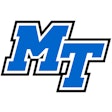
Ohio State University will retain all of its current 36 Division I teams and all of those teams' scholarships, president Ted Carter announced in his investiture address Friday afternoon.
"Collegiate athletics is one of our focus themes because we want to retain the student-athlete model for which we are a national leader," Carter told The Columbus Dispatch in advance of his address.
According to Dispatch higher education reporter Sheridan Hendrix, Carter said college athletics is the "front porch" to the university and one of the core themes he laid out in his 10-year framework: "Education for Citizenship 2035."
"Carter said there are still a lot of decisions yet to be made and what exactly the athletics department will look like, but he said Friday that he and Ohio State athletic director Ross Bjork are committed to maintaining the student-athlete model," Hendrix wrote.
"It is so important that we hold onto the student-athlete model," Carter said.
Ohio State has more than 1,000 student athletes who boast a 94% graduation rate and an average 3.3 GPA, Carter said.
"We want to be a voice in making sure that in the shared revenue, NIL, transfer portal world... that we retain our student athletes as student athletes," Carter told the Dispatch on Thursday. "In other words, when you come here and wear the uniform of Ohio State, you're here to get a degree."
"Yes, we expect conference champions and national champions," he added. "But we can do both."
"Carter's announcement comes in the midst of ongoing discussion related to House v. NCAA, an antitrust lawsuit filed against the NCAA brought by former Arizona State swimmer Grant House in 2020 challenging the NCAA's name, image and likeness rules," Hendrix reported. "The settlement, approved by the NCAA in May, combines three antitrust cases brought by student-athletes.
"In short, the settlement allows schools to directly pay their athletes, an extraordinary change for an association and member schools and conferences that had spent years and tens of millions of dollars in legal and lobbying costs fighting the idea, USA Today previously reported."
As reported by Hendrix, the settlement requires $2.8 billion in backpay to former NCAA athletes over a 10-year period, and allows schools to opt into revenue sharing going forward. Universities can share up to 22% of their average athletic revenues. That equals more than $25 million annually.
Hendrix added that many individuals across the country have reportedly faced uncertainty regarding their status as collegiate student-athletes, with some losing scholarships or their roster spots entirely. Athletes participating in Olympic sports appear to be in a particularly precarious position in the wake of the House decision, Hendrix reported.
According to SwimSwam, local Columbus media reported a month ago that the men’s gymnastics program was told it they would no longer be able to offer athletic scholarships to student-athletes, with other sources telling SwimSwam that they were one of several sports to be told the same, including artistic (synchronized) swimming.
The context centered on comments in August by Bjork that rosters would be cut and some sports would "act a little bit more like a club sport" as part of a new tiered athletics department for the Buckeyes. Bjork said that the school would retain all 36 athletics programs at that time.





































